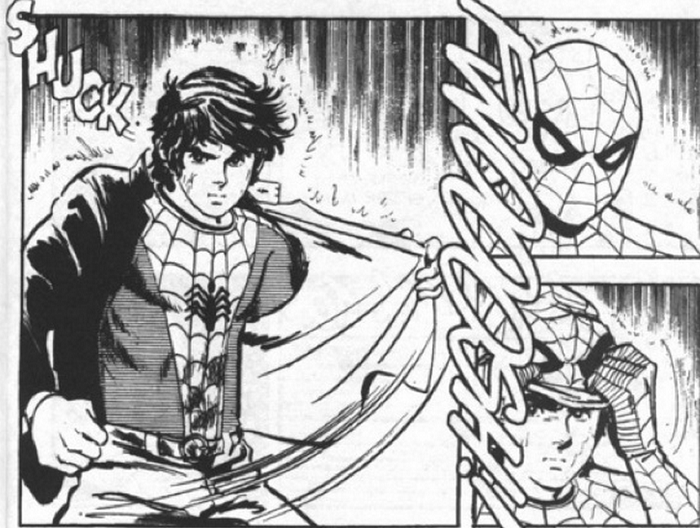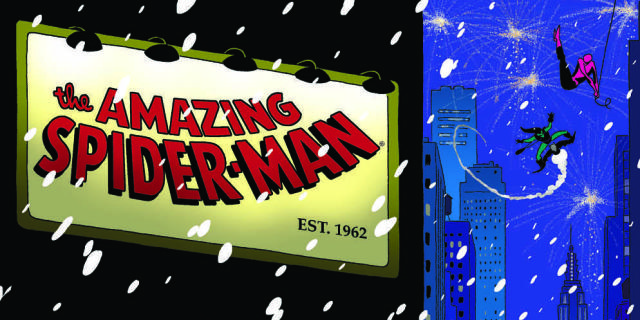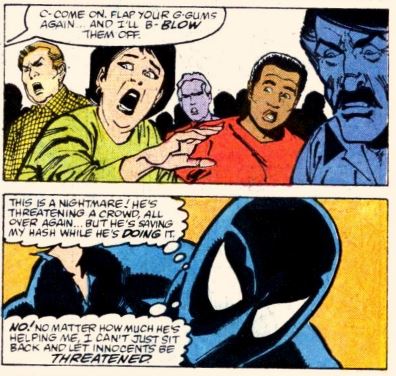One of the weirdest official projects that’s ever going to be covered on this website is the original Spider-Man the Manga, and just as odd is the way Marvel published in the United States.
Here I’m going to write about the unusual and dated ways in which manga was published in the United States. Some of this is going to be very basic, although details about how I experienced comics might seem strange to anyone who picked it up a little bit later.
In Japan, manga is mainly published black and white in anthology magazines, which are later collected in digest sized volumes. Early manga in the United States was published in a standard black and white comic book format, typically with 28 or so pages an issue expanded to the standard American dimensions of 6.63″ x 10.24″ at a cover price of three dollars. Some popular series were told in 14 page instalments, so that was a relatively easy adaptation. In other cases, a volume would be broken up into smaller installments, with pages removed because of content concerns or because they just needed a good moment to end the issue. The results could be unsatisfying when key scenes are missing or truncated.
If you’ve read manga, you know that 28 pages for three dollars is not a good dollar per minute of enjoyment ratio. And this was in the 90s. When Spider-Man the Manga was published in the US with a cover price of $2.99, Amazing Spider-Man prices had recently increased to $1.99. This may be why American publishers have shifted to anthologies and the majority of current sales are in the digest/ graphic novel format.

It didn’t sell well, although they made a last-ditch effort to promote the series was an exclusive cover by Joe Madureira, at the time one of the most popular artists in comics. They used the same picture twice for two consecutive covers, with slightly different framing.
I do want to note that this Japanese project is very different from the Super Sentai style TV show, where their version of Spider-Man had a leopard based robot. There have been other manga adaptations, as well as manga-influenced takes on the wall-crawler.
This version of Spider-Man the Manga was made in the 1970s, and lasted for thirteen adventures. It was illustrated by Ryoichi Ikegami, who would go on to draw the very mature rated assassin series Crying Freeman. It was initially written by Kōsei Ono, who would be best recognized in Japan as a major translator for American comics like Maus and Bone, and later Kazumasa Hirai, best known for his science fiction work.

This character is not named Peter Parker, but called Yu Komori. However, he starts out similar to Peter, as a lonely young man interested in science who gets bitten by a radioactive spider.
The first issue includes commentary from FOOM (the Friends of Old Marvel magazine) #22, as Gene Pelc, Marvel’s man in Japan, realized that there wasn’t a market for Japanese translations of Spider-Man, but there was a market for new stories.
I was meeting a lot of young people, artists, writers, television people, who kept telling me that American comics were good for Japan. They liked them and thought that the superheroes would work. But obviously something was wrong. Something was not translating or coming across. A Japanese guy said that he could read them and enjoy them, but he couldn’t take them home and just soak in the bathtub and enjoy Spider-Man… that something was missing.
While American comics have become much more cinematic in the last few decades, that was not the case in the 1970s when Marvel was experiencing the bronze age, and trying to sell translations of silver age comics. The Japanese audience was used to different pacing.
Spider-Man the Manga was translated in the United States at around the same time as an X-Men manga, which largely adapted the 1990s Fox cartoon, which itself adapted stories from the Lee/Kirby run or from Chris Claremont and his collaborators.
Information on it is weirdly limited. Tom Brevoort wrote the foreword to the first issue, but I can’t find anything else he said about the project. It’s easier to find fan translations of some of the stories they never published than it is to find any commentary about why it was cancelled, or whether Marvel ever had plans to do more with it.
I should mention an early exposure to the manga. I went to Estonia with family, and I remember seeing a store that had a Spider-Man inflatable outside. I went inside, and they had copies of the manga, which was kinda nuts, and does exemplify how the manga might pop up in all sorts of weird places.
Ed Piskor and Jim covered it in their Youtube series Cartoonist Kayfabe, reading through the first issue and commenting on it.
There are other videos about it that have 50,000+ views. Mangalog covers it, although it does spoil the endings of the first two volumes.
At this point, Censoredgaming’s spotlight has had 230,356 viewers.
An underappreciated point is that this series was only around for a year and half in Japan, even if it produced a good amount of material, easily over 1,000 pages of content which would be equivalent to a series that lasted for fifty issues in the United States. This was all with the same artist, although they changed writers as a solution to low sales.
An obvious question is why this disappeared so quickly. When Marvel went through the effort of translating original volumes, why not release the digests especially when manga became even more popular in the 2000s? Why allow one story to be unfinished, and four to never be translated? It just can’t be that controversial. Right?
In the next edition, we’ll take a look at some of the material Marvel published with the translated work of Kōsei Ono and Ryoichi Ikegami.
Have any of you checked out the series? What did you think of it? Should Marvel do more with the translations, or forget it ever existed?









